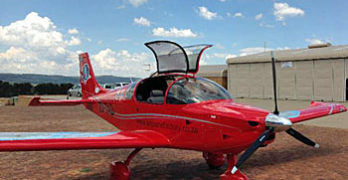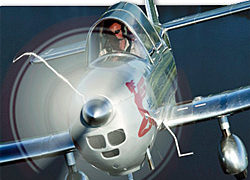Less than two weeks from now, the season of recreational flying is officially set in motion with the opening of Sun ‘n Fun … the 40th year of the nation’s first major airshow. It will also be year #2 for the new and much-improved Paradise City, formerly known as the Ultralight or Lightplane Area. Alongside the curvy new paved road that loops through Paradise City will sit the LSA Mall at Show Center powered by Aviators Hot Line and this is a place many will visit throughout the week to peruse LSA, light kit airplanes, and electric aircraft. Getting to the Paradise City will be much easier and faster thanks to a pair of six-seat golf carts that will rove the grounds of Sun ‘n Fun and pick up visitors who want to check out Paradise and all the action at this airshow-within-an-airshow. Demo flights for LSA shoppers will be readily available and can be conducted all day long even during the main airshow aerobatics (except for a 1-2 hour period when military teams demand “sterile airspace”).
Search Results for : electric
Not finding exactly what you expected? Try our advanced search option.
Select a manufacturer to go straight to all our content about that manufacturer.
Select an aircraft model to go straight to all our content about that model.
LSA Alive & Well: Slings in Stock; Evektor Sales
The Great Recession was the pits … for nearly all industries and most employees or small business owners. That’s hardly newsworthy. However, the recovery from the recession — that government economists insist ended years ago — has been a long time coming. For too many out-of-work pilots, that recession lingers with us yet. Fortunately, the aviation economy appears to be improving. Although registrations didn’t show it for 2013, the year provided more sales for sellers if not more airplanes for their customers. Now, the hope is that airplanes will emerge from factories faster and the general health of the industry will improve, which is good for seller and buyer alike. A couple companies have proof that things are looking up and I’d like to tell you a little about them.
First is South Africa’s The Airplane Factory (TAF) and their rep’, TAF USA, led by Matt Litnaitzky and associate Ryan Ruel.
Flying the Zigolo Motorglider … a Pilot Report
For many of us, the principal reason we fly is for fun. Not to go anywhere but up, or for no other reason than that the sky is always waiting, but never impatient. Unfortunately this very pure idea became subverted along the way, as the Cubs and Champs of our forefathers were replaced by the efficient but banal 150 and PA28.
As the fun diminished the costs rose in proportion. One of the original ideas behind the whole LSA concept was affordability, but with some aircraft now priced up to $200,000 that particular principle seems to have been forgotten [though more modestly priced LSA do remain available]. Consequently, when Chip Erwin of Aeromarine LSA told me at the 2014 Sebring LSA Expo that he was bringing a new aircraft to market that required minimal assembly yet cost only $16,000 including the motor and a parachute rescue system you can bet I was interested.
Last News Rush Before Sebring 2014 …
People are starting to arrive in Florida. Today, we had a pleasant lunch conversation with Dynon’s president Robert Hamilton. He observed that Dynon enjoyed their best year ever in 2013 and they continue bringing new avionics innovations at modest prices. Fellow Dynon staffer Kirk Kleinholz was in the state even earlier traveling around offering tech support. Great work, Dynon-ers! As we all enter the last-minute rush to head to the tenth Sebring, a few news items arrived and I’ll run through them so you have some idea of what will be present at the LSA event.
Progressive Aerodyne announced they received FAA acceptance for the Elite version of their Searey Amphibious LSA. Searey Elite is mightily powered with a Rotax 914 turbocharged engine; you can see a short video of it launching in this article. “This stylish aircraft offers many advanced features such as a large sliding canopy that can remain open while flying.
Sebring No-Show Bargains Will Attend Sun ‘n Fun
Not long ago, I posted about Kitfox tending to business and expressing regret that they chose to stay home in Idaho versus making the trip to the Sebring LSA Expo 2014. Team Kitfox was not the only one, however. In addition, AeroSport didn’t bring their BushCat, nor did Aerotrek bring their A220 or A240, nor did Quicksilver show with their SLSA candidate, Sport 2S, or their joint venture Electric Motor Glider (a very cool project from the west coast about which I will do a further update in the future). The reasons for these no-shows were varied but the good news is that they’ll be at Sun ‘n Fun. Oh, and one more thing about all four aircraft mentioned below: each of them offers a purchase value that defies the current mindset about the cost of modern LSA.
BushCat by SkyReach is one of those SLSA that easily answers the lament, “These LSA have become too expensive.” Too many pilots say this without considering their other choices.
Jabiru Schedules Engine Seminar in Florida
In the LSA space, we presently have five engine suppliers that either have ASTM approval or FAA certification approval that grants them the chance to power Light-Sport Aircraft. The five brands are: Rotax, Continental, Jabiru, Lycoming, and HKS. For customers who like doing their own maintenance or for mechanics who want to have all the knowledge they need, company-presented seminars are invaluable. Since they have decades of history and a have been used on Type Certified airplanes, Continental and Lycoming enjoy broad awareness of mechanics around the world. Rotax has also pursued regular training for mechanics to work on their engines. Jabiru has also done these and their U.S. distributor just announced their latest in the Sunshine State of Florida.
Peter Krotje of Jabiru USA Sport Aircraft, LLC, sent notice of a two day seminar to take place over February 7th and 8th, 2014 at Voyager Aviation Services on Merritt Island (street address for GPS-equipped drivers: 475 Manor Drive; zipcode 32952).
Quick, say “Octodecacopter”…and Welcome the Future
It’s premature if not off the point to say this exotic, beautiful prototype will be the death of the helicopter. I will flat out make a prediction: a whole new type of flight is here … and it will change everything … and I mean everything about how we fly.
I was musing the other day, while catching up on the latest multi-rotor RC model technology with which to populate my Christmas wish list, about how long it would take before we saw a serious effort to build a human-carrying version. Clearly I was way behind the buzz curve: talk about instant gratification! E-volo of Karlsruhe, Germany has just made a lightspeed leapfrog over pretty much every other vertical takeoff/landing design or project I’ve heard about. The gamechanger: the just-maidened VC200 Volocopter. Watch the video, then read on. This project and others like it is going to change flight as we know it, make no mistake.
LAMA (Europe) Investigates the China LSA Market
My LAMA Europe counterpart and friend, Jan Fridrich, took another trip to China in October as he attended Xi’an, said to be the largest General Aviation exhibition in the country. While the show was large with expansive, expensive exhibit stands, airplanes were sparser than events such as Aero Friedrichshafen. Like a few American events (thinking of AOPA’s just concluded Summit and NBAA’s giant show), Xi’an’s convention hall housed indoor displays while the “static” display of more airplanes was at an airport. U.S. organizers usually try to colocate these two displays. In contrast, Jan reported, “The static exhibition was at the airport in Pucheng, which is about 100 kilometers (62 miles) from Xi’an! Practically speaking, it was only accessible by bus and only during one official day and the journey takes 2.5 hours … Without Chinese friends it is very complicated to get anywhere.” Jan added that viewers at the airport were unable to get within 60 feet of airplanes.
Flying Sam; “A Warbird for the LSA Market”
To some it’s a new entry in the LSA race (Sam LS is presently selling kits while pursuing SLSA acceptance). To others the Canadian LSA is a “mini T-6” or a “mini Yak 52.” Either characterization no doubt pleases designer Thierry Zibi. During development he did a thorough job of asking airshow visitors what appealed to them. Now that Sam is flying, it is fair to say that even with the availability of 132 other Light-Sport Aircraft models, Sam LS is unique. At AOPA’s last-ever Summit event in Fort Worth, Texas, I got a chance to take Sam aloft with Thierry overseeing from the aft seat. Short tell: it may look like a miniature warbird, but flies with very solid and pleasant qualities.
As the sun-drenched photos reveal, Thierry’s airplane glistens with polished aluminum, an uncommon appearance on airport ramps loaded with brightly painted aircraft accented with jaunty striping.
Rans Aircraft in the News … Twice!
After losing the trim tab on the elevator of his Rans S-6, John Pederson of Lombard, Illinois grappled with a violent shaking and executed an emergency landing on Chicago’s Lake Shore Drive. He was flying very early so traffic on the multi-lane route was light. Pederson reported timing his landing to avoid any traffic, though local sources reported the airplane was struck by two autos both of which sped away afterward. Unable to regain stability, the 51-year-old electrician radioed a mayday to O’Hare International Airport and then set up for landing. A recording of the radio call revealed John behaving calmly and, indeed, no one was injured in the highly-publicized incident. “At the time of the mayday call, about 6 a.m., he was flying about 1,900 feet above [Chicago’s downtown] Millennium Park, he said,” according to a report on the Chicago Tribune‘s online website.
The good news is no one was injured and while media reports poked fun at Pederson’s very visible downtown Chicago landing, the report can nonetheless be viewed more or less positively.
- « Previous Page
- 1
- …
- 33
- 34
- 35
- 36
- 37
- …
- 67
- Next Page »











